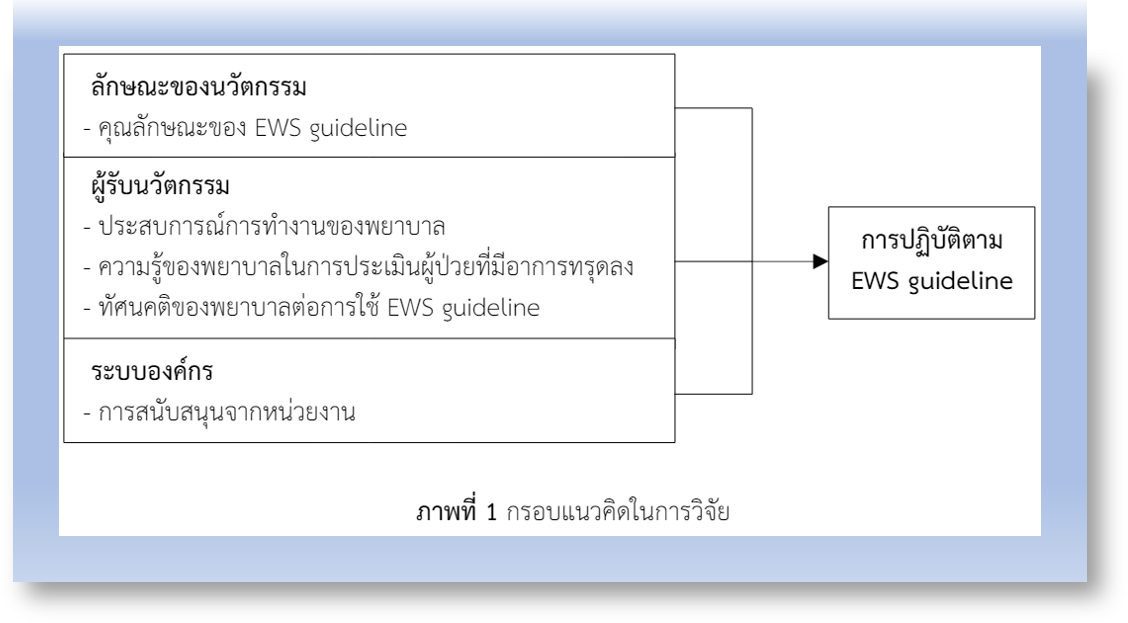ปัจจัยทำนายการปฏิบัติตามแนวปฏิบัติการประเมินสัญญาณเตือนในระยะแรกของพยาบาลวิชาชีพ
คำสำคัญ:
แนวปฏิบัติการประเมินสัญญาณเตือนในระยะแรก, การปฏิบัติตาม, พยาบาลวิชาชีพบทคัดย่อ
การวิจัยความสัมพันธ์เชิงทำนายนี้ มีวัตถุประสงค์เพื่อ ศึกษาปัจจัยทำนายการปฏิบัติตามแนวปฏิบัติการประเมินสัญญาณเตือนในระยะแรก (early warning sign guideline: EWS guideline) ของพยาบาลวิชาชีพ กลุ่มตัวอย่าง คือ พยาบาลวิชาชีพ จำนวน 290 ราย คัดเลือกแบบเจาะจง เก็บข้อมูลด้วยแบบสอบถาม 6 ส่วน ประกอบด้วย 1) ข้อมูลส่วนบุคคล 2) คุณลักษณะของ EWS guideline 3) ความรู้ในการประเมินผู้ป่วยที่มีอาการทรุดลง 4) ทัศนคติต่อ EWS guideline 5) การสนับสนุนจากองค์กร และ 6) การปฏิบัติตาม EWS guideline ค่าดัชนีความตรงเชิงเนื้อหาอยู่ระหว่าง .80 - 1.00 และค่าสัมประสิทธิ์อัลฟาของครอนบาคของเครื่องมือส่วนที่ 2 - 6 เท่ากับ .90, .18, .80, .90 และ .90 ตามลำดับ วิเคราะห์ข้อมูลด้วยสถิติเชิงพรรณนา สถิติสหสัมพันธ์แบบสเปียร์แมน และสถิติวิเคราะห์การถดถอยพหุคูณ
ผลการศึกษา พบว่า ตัวแปรปัจจัยทำนายทั้ง 5 ตัวแปร สามารถร่วมกันทำนายการปฏิบัติตาม EWS guideline ของพยาบาลวิชาชีพ ได้ร้อยละ 12.70 อย่างมีนัยสำคัญทางสถิติ (R2 = .127, p-value < .05) ปัจจัยที่สามารถทำนายการปฏิบัติตาม EWS guideline ของพยาบาลวิชาชีพได้อย่างมีนัยสำคัญทางสถิติ คือ คุณลักษณะของ EWS guideline (b = .172, p-value < .05) และการสนับสนุนจากองค์กร (b = .126, p-value < .05) จากผลการศึกษานี้ ผู้บริหารการพยาบาลควรจัดอบรม และสนับสนุนการใช้ EWS guideline แก่พยาบาล ตลอดจนประเมินทัศนคติของพยาบาลต่อการนำ EWS guideline ไปปฏิบัติในการดูแลผู้ป่วย
เอกสารอ้างอิง
Healthcare Quality Accreditation Institute (Public Organization). Patient safety goals: SIMPLE Thailand 2018. Nonthaburi: Famous and Successful; 2018. (in Thai)
Andersen LW, Holmberg MJ, Lofgren B, Kirkegaard H, Granfeldt A. Adult in-hospital cardiac arrest in Denmark. Resuscitation 2019;140(1):31-6. doi: 10.1016/j.resuscitation.2019.04.046.
Doyle DJ. Clinical early warning scores: new clinical tools in evolution. The Open Anesthesia Journal 2018;12(1):26-33. doi: 10.2174/2589645801812010026.
Badr MN, Khalil NS, Mukhtar AM. Effect of national early warning scoring system implementation on cardiopulmonary arrest, unplanned ICU admission, emergency surgery, and acute kidney injury in an emergency hospital, Egypt. Journal of Multidisciplinary Healthcare 2021;14:1431-42. doi: 10.2147/JMDH.S312395.
Sirisaen K, Hinjiranan S, Changmai S. The effectiveness of the early warning sign in nursing patients in the intensive care unit a private hospital in Bangkok. Thai Journal of Nursing 2015;64(3):54-61. (in Thai)
Hwang JI, Kim SW. Using an early warning score for nurse shift patient handover: before-and-after study. Asian Nursing Research 2022;16(1):18-24. doi: 10.1016/j.anr.2021.12.005.
Petersen JA, Rasmussen LS, Rydahl-Hansen S. Barriers and facilitating factors related to use of early warning score among acute care nurses: a qualitative study. BMC Emergency Medicine 2017;17(1):36. doi: 10.1186/s12873-017-0147-0.
Jensen JK, Skar R, Tveit B. Introducing the national early warning score - a qualitative study of hospital nurses’ perceptions and reactions. Nursing Open 2019;6(3):1067-75. doi: 10.1002/nop2.291.
Roger EM. Diffusion of innovations. 5th ed. New York: Simon and Schuster; 2003.
Faculty of Medicine Vajira Hospital, Navamindradhiraj University. Action plan. Department of nursing. Bangkok: Faculty of Medicine Vajira Hospital, Navamindradhiraj University; 2020. (in Thai)
Royal College of Physicians. National early warning score (NEWS) 2 standardising the assessment of acute-illness severity in the NHS [Internet]. 2020 [cited 2023 Nov 17]. Available from: https://www.rcp.ac.uk/media/umzn4ntq/news2_additional-guidance-002-_0.pdf
Faul F, Erdfelder E, Buchner A, Lang AG. Statistical power analyses using G*Power 3.1: tests for correlation and regression analyses. Behavior Research Methods 2009;41(4):1149-60. doi: 10.3758/BRM.41.4.1149.
Sornchai N, Duangpaeng S, Kunsongkeit W. Factors predicting nursing practice following the clinical nursing practice guidelines for urinary catheterized patients at Sawanpracharak hospital. The Journal of Faculty of Nursing Burapha University 2007;15(4):63-75. (in Thai)
Nursing development of vajira hospital. Work instruction. Early warning signs guideline. WI-NUR01-EWS-01. 2 nd; 2019. (in Thai)
Phillips SC. Evaluation of the modified early warning score (MEWS) screening tool for physiological signs of sepsis and the burden on emergency department registered nursing staff [Dissertation]. East Cameron Ave: University of North Carolina at Chapel Hill Graduate School; 2017. doi: 10.17615/8794-6q86.
Duran AA. Factors influencing the use of the modified early warning score (MEWS) to identify patient deterioration [Dissertation]. Tucson: The University of Arizona; 2019.
Valiee S, Salehnejad G. Barriers to and facilitators of nurses’ adherence to clinical practice guidelines: a qualitative study. Creative Nursing 2020;26(1):e1-7. doi: 10.1891/1078-4535.26.1.e1.
Richemond D, Needham M, Jean K. The effects of nurse burnout on patient experiences. Open Journal of Business and Management 2022;10(5):2805-28. doi: 10.4236/ojbm.2022.105139.
Suetowong S. Factors related to the use of SOS score as a warning signal before entering crisis among professional nurses [Internet]. 2017 [cited 2024 May 23]. Available from: www.cbh.moph.go.th/app/intranet/files/km/1507187169_14.%20สมศรี%20%20ซื่อต่อวงศ์.pdf (in Thai)
Thaiautvitee T, Jumpamool A. Factors influencing patient - centered care as perceived by registered nurses working in Srinagarind hospital, Khonkaen university. Srinagarind Medical Journal 2019;34(2):198-204.
Bunruam C, Unahalekhaka A, Lertwatthanawilat W. Factors predicting practices in prevention of drug resistant organism transmission among registered nurses in regional hospitals. Nursing Journal CMU 2020;47(2):133-42. (in Thai)

ดาวน์โหลด
เผยแพร่แล้ว
รูปแบบการอ้างอิง
ฉบับ
ประเภทบทความ
สัญญาอนุญาต
ลิขสิทธิ์ (c) 2024 วารสารเกื้อการุณย์

อนุญาตภายใต้เงื่อนไข Creative Commons Attribution-NonCommercial-NoDerivatives 4.0 International License.














